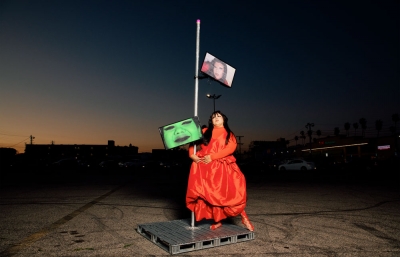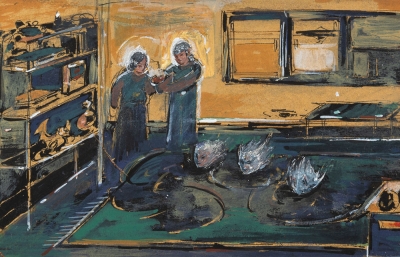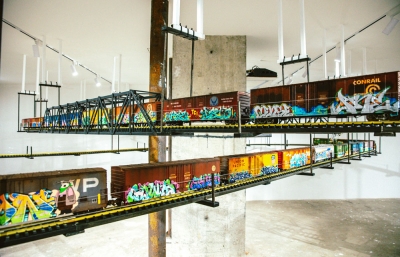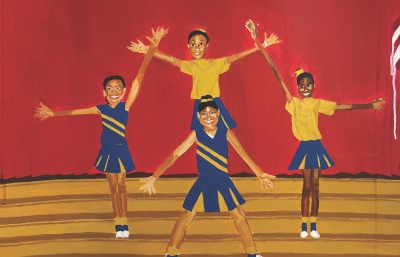Looking into the eyes of legendary photographer Julian Wasser, one truly senses that he can see right through you. Julian has very strong opinions about a plethora of topics. Not shy, he’ll press his life advice on those he deems worthy of his attention, whether or not they’ve asked for it. Although he is clearly in his later years, he still refuses to divulge his age.
All photographs courtesy the artist.
After starting his career in the Washington bureau of the Associated Press news service, he went on to create some of the most memorable images of the past century. His shots have graced the covers and pages of every major publication—Time, People, Vanity Fair, TV Guide, Playboy, Vogue, Der Spiegel—you name it. Julian Wasser has a knack for being in the right place at the right time.
Perhaps his most notorious photo session was of groundbreaking artist Marcel Duchamp playing chess with a naked Eve Babitz in 1963 at the Pasadena Museum of Art during Duchamp’s first retrospective. Organized by Walter Hopps, then director of the museum (now the Norton Simon Museum), the exhibition was the first comprehensive survey of Duchamp’s storied career, which began in 1911 at the legendary Armory show in New York. Duchamp, by this time, was the most influential artist in the world, having revolutionized the modern art world with his unconventional concepts. At the time, he had retired from being an artist to pursue his passion for chess.
His numerous works had never been shown collectively, and the landmark show is still considered to be one of the seminal exhibitions of all time. The opening night was a who’s who of the most highly-regarded artists and collectors of the era, and effectively inaugurated the establishment of the Pop art movement. Among the group of up-and-coming artists who attended were Andy Warhol, Billy Al Bengston and Ed Ruscha.
I recently collaborated with art dealer Robert Berman to create replicas of Duchamp’s various works from that seminal show to accompany an exhibition of Julian Wasser’s photographs, which opened last May in San Francisco and will head to Los Angeles at the beginning of 2016. It was an immersive journey to delve into the artist’s mind and his dynamic working process. I recreated many of his most famous artworks, including Nude Descending a Staircase, the monumental glass work The Bride Stripped Bare by Her Bachelors, Even, and found a urinal that closely matched his most scandalous sculpture, entitled Fountain. To bring the show full circle, I constructed an installation of silhouette cutouts portraying Duchamp and Babitz in the famous Wasser photo.
I sat down with the photographer at the Robert Berman Gallery in Santa Monica to talk about the upcoming survey, titled Duchamp in Pasadena Redux. He extolled the virtues of a healthy lifestyle and waxed poetic about his most famous photograph.

Portrait by Gregg Gibbs
Gregg Gibbs: How did you end up photographing the Duchamp retrospective in 1963?
Julian Wasser: Time magazine kept giving me assignments to photograph famous artists. At the time, it was guys like Ed Ruscha, who later became even more famous. It was the start of the Pop season. They gave me a plane ticket to go out and photograph this artist, Marcel Duchamp. Finally, someone had given him a retrospective. Walter Hopps was a genius—he was a really respected guy in the art world. He was the chief curator and the perfect guy for that period.
Tell me about the opening night reception for the exhibition.
Incredible. It was electric. Everybody from the art world from the East Coast to the West Coast was there. You just knew you’d never see anything like it again. It was really something, you could feel it. Duchamp wasn’t getting much attention up until then. This was Time magazine, which was a big deal for an artist. It was the end of the rainbow. You always stay with the principal [subject], so I just stayed with him the whole time. He put himself at my disposal.
As an underground figure, Duchamp was not necessarily popular with the general public. He railed against “retinal art,” emphasizing that the idea was more important than the object, even going to the extent of exhibiting a urinal signed “R. Mutt.” Did you know much about Duchamp’s ideas at the time?
Not really. He was a really big deal in the art world. I didn’t realize he was the father of Pop art in this country. He was a Dadaist who suddenly inspired the new art movement. I remembered he did that piece, Nude Descending a Staircase, for the 1913 Armory show. So I went out there and figured he liked girls with big boobs. That gets men’s attention all the time. So I got Eve to pose with him.

Can you tell me about Eve Babitz? She’s quite famous for her liberated ideas about sexuality and her celebrity dalliances around that time.
Well, look at her body. She was like a woman you’d see in a painting in the Louvre. What a natural she was. Her social life was being everybody’s girlfriend—a trendy girl. Let me tell you about something that happened later. One day, at some event, she was smoking one of her cigarillos in a beautiful rayon dress, and an ash fell on her dress. It caught on fire, and burned about 80% of the nerves in her body. Today she is horribly burned, in her 70s, living alone.
Let’s get back to the Pasadena retrospective. How did you get her to cooperate with your plan?
I said to her, “Eve, I gotta photograph this artist. Do you want to model for me for this shoot I’m doing?” She knew all about Duchamp. She was thrilled—it was the biggest thing in her life. She was all for it. So I picked her up and we went to the museum in the early morning before it opened. We went in there, and there’s Marcel, this old gent. Opposite him is this naked goddess with a full body. And they simulate a chess match with all his [art] pieces behind him. He couldn’t stop looking at her. I didn’t notice what was going on. I just took the pictures.
Isn’t it true that she was having an affair with Walter Hopps and that he didn’t invite her to the opening night?
She wasn’t invited to the opening, so she thought she’d get naked in front of Walter and he would freak out. Again, I was just taking pictures.
So you came up with the idea of Duchamp playing chess with a nude. What did Time magazine think about that?
They never knew what they wanted. You never ask much because that would screw the whole thing up. They hired me to use my imagination and get something different. I just decided, I’ll have him with a nude playing chess—it just worked out that way. It was just another job. That picture is so popular, but it never ran in the magazine. Thank God, because I retained all the rights. Every artist in the world knows that picture—it strikes a chord.
----
Read the full interview in the February, 2015 issue of Juxtapoz, on sale now.















